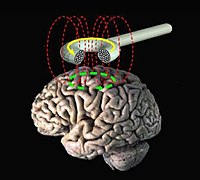
Photo from wikipedia
NICE guidance for patients with rheumatoid arthritis (RA) (NG100) states all patients should receive an annual review appointment. This should encompass assessment of disease activity metrics, co-morbidity review and appropriate… Click to show full abstract
NICE guidance for patients with rheumatoid arthritis (RA) (NG100) states all patients should receive an annual review appointment. This should encompass assessment of disease activity metrics, co-morbidity review and appropriate onward referral to other healthcare professionals. A preliminary snapshot service review in 2020 had suggested that our department’s adherence to NICE RA guidance was inconsistent. This assessed small patient numbers, so a larger audit was devised enabling us to better understand current practice and inform areas for future development. NG100 was fully reviewed, and relevant audit standards devised. JE and BM created metrics demonstrating compliance with guidance; areas requiring clarification were discussed with AA. 3400 adult RA patients were identified under the care of the department. The records of 340 patients were selected for review using convenience sampling. All clinic encounters were reviewed for 12 months prior to an identified appointment in January 2019. Data was collected by HC, reviewed by JE, and analysis completed by HC, JE and AA. Female to male ratio was 2.33:1, mean age was 65.9 (SD = 12.3), median DAS28 score was 2.94 (IQR=2.01), median VAS score was 40.0 (IQR=63.5). 74% (n = 251/340) of patients were reviewed more than once in 12 months. 41% (n = 141/340) of appointments were with nurses, 35% (n = 118/340) with consultants, 10% (n = 34/340) with SHOs, 14% (n = 47/340) with registrars. DAS28 was documented for 74.4% (n = 253/340) of patients. Presence or absence of erosions was documented for 42% (n = 144/340) of patients. Blood pressure was documented in 33% (n = 113/340) of patients, 18% (n = 60/340) patients were known to have hypertension, 6% (n = 20/340) of patients had ischemic heart disease. Assessment for metrics relating to audit standards: mental health screen 7.9% (n = 27/340), neck pain 14% (n = 46/340), respiratory symptoms 21% (n = 72/340), eye symptoms 21% (n = 70/340), bone health 27.9% (n = 95/340). There was documented consideration of referral to allied health professionals in 38% (n = 128/340) and to surgical teams in 18% (n = 61/340). Quantitative assessment of patient-reported outcome measures (PROMs) included: VAS 73% (n = 248/340), HAQ 22% (n = 76/340). There is variation amongst clinicians in documenting NICE guidance annual review targets for RA; this may reflect time pressure in clinics, incomplete documentation, and unclear delineation of primary and secondary care roles. Secondary care should be aware of the quality framework targets for primary care relating to RA monitoring to encourage collaboration and optimise use of resources. Developing virtual assessments and PROM tools provides new opportunities for shared responsibility of care between clinicians and patients; this could improve patient outcomes. We are developing a digital RA annual review tool incorporating PROMs to simplify documentation and reduce pressures on clinic times; this may improve patient and clinician experience. Disclosure H. Cooney: None. J. Ellis: None. B. Mulhearn: None. A. Allard: None.
Journal Title: Rheumatology
Year Published: 2023
Link to full text (if available)
Share on Social Media: Sign Up to like & get
recommendations!